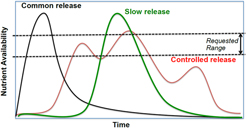Crossref Citations
This article has been cited by the following publications. This list is generated based on data provided by
Crossref.
Giroto, Amanda S.
do Valle, Stella F.
Guimarães, Gelton G. F.
Molina, Arthur
Reis, Heitor P. G.
Fernandes, Dirceu M.
Bernardi, Alberto C. C.
Mattoso, Luiz H. C.
and
Ribeiro, Caue
2020.
Tailoring Efficient Materials for NPK All-in-One Granular Fertilization.
Industrial & Engineering Chemistry Research,
Vol. 59,
Issue. 41,
p.
18387.
Pereira, Tamires dos Santos
Dias Neves Binotto, Vilma Damian
and
Faez, Roselena
2020.
Multilayer films of carboxymethylcellulose/zeolite as smart materials for macro and micronutrients delivery.
Microporous and Mesoporous Materials,
Vol. 302,
Issue. ,
p.
110195.
Ribeiro, Caue
and
Carmo, Marcelo
2020.
Why nonconventional materials are answers for sustainable agriculture - ADDENDUM.
MRS Energy & Sustainability,
Vol. 7,
Issue. 1,
Guimarães, Gelton G. F.
and
Ribeiro, Caue
2021.
Kirk-Othmer Encyclopedia of Chemical Technology.
p.
1.
Mejias, J. H.
Salazar, F.
Pérez Amaro, L.
Hube, S.
Rodriguez, M.
and
Alfaro, M.
2021.
Nanofertilizers: A Cutting-Edge Approach to Increase Nitrogen Use Efficiency in Grasslands.
Frontiers in Environmental Science,
Vol. 9,
Issue. ,
França, Débora
de Barros, João Ricardo Shibata
and
Faez, Roselena
2021.
Spray-dried cellulose nanofibrils microparticles as a vehicle for enhanced efficiency fertilizers.
Cellulose,
Vol. 28,
Issue. 3,
p.
1571.
do Valle, Stella Fortuna
Giroto, Amanda Soares
Reis, Heitor Pontes Gestal
Guimarães, Gelton G. F.
and
Ribeiro, Caue
2021.
Synergy of Phosphate-Controlled Release and Sulfur Oxidation in Novel Polysulfide Composites for Sustainable Fertilization.
Journal of Agricultural and Food Chemistry,
Vol. 69,
Issue. 8,
p.
2392.
dos Santos Pereira, Tamires
Fernandes, Larissa Santos
Souza, Claudinei Fonseca
and
Faez, Roselena
2021.
Biodegradable Enhanced Efficiency Fertilizer Based on Biopolymers/Zeolites Films’ Assembly.
ACS Agricultural Science & Technology,
Vol. 1,
Issue. 3,
p.
131.
Avila-Quezada, Graciela Dolores
Ingle, Avinash P.
Golińska, Patrycja
and
Rai, Mahendra
2022.
Strategic applications of nano-fertilizers for sustainable agriculture: Benefits and bottlenecks.
Nanotechnology Reviews,
Vol. 11,
Issue. 1,
p.
2123.
Das, Saurav
and
Beegum, Sahila
2022.
Agricultural Nanobiotechnology.
p.
355.
Lodi, Matteo B
Sivasubramani, Santhosh
Berkenbrock, Jose
Vieira, Daniela
Welsch, Tory
Li, Yi
and
Sliz, Rafal
2022.
The First Edition of the World Nanotechnology Marathon [Spotlight Column].
IEEE Nanotechnology Magazine,
Vol. 16,
Issue. 5,
p.
9.
Wang, Yanjie
Torres, Juliana A.
Shviro, Meital
Carmo, Marcelo
He, Tao
and
Ribeiro, Caue
2022.
Photocatalytic materials applications for sustainable agriculture.
Progress in Materials Science,
Vol. 130,
Issue. ,
p.
100965.
Valle, Stella F.
Giroto, Amanda S.
Guimarães, Gelton G. F.
Nagel, Kerstin A.
Galinski, Anna
Cohnen, Jens
Jablonowski, Nicolai D.
and
Ribeiro, Caue
2022.
Co-fertilization of Sulfur and Struvite-Phosphorus in a Slow-Release Fertilizer Improves Soybean Cultivation.
Frontiers in Plant Science,
Vol. 13,
Issue. ,
Vîlcoci, Denisa Ştefania
Sutan, Nicoleta Anca
Drăghiceanu, Oana Alexandra
Soare, Liliana Cristina
and
Cîrstea, Georgiana
2023.
Nanoformulations for Sustainable Agriculture and Environmental Risk Mitigation.
p.
18.
Zamel, Doaa
Elsalahaty, Mohamed I.
Khan, Allah Nawaz
AlKafaas, Samar Sami
and
Khan, Atta Ullah
2023.
Functionalized Nanofibers.
p.
437.
Valle, Stella F.
Giroto, Amanda S.
and
Ribeiro, Caue
2023.
Unveiling the Role of Polysulfide Matrices in Phosphate Diffusion for Controlled Release Fertilizers.
ACS Applied Polymer Materials,
Vol. 5,
Issue. 9,
p.
6941.
Mishra, Rahul
Sahu, Nisha
Saha, Madhumonti
Sarkar, Abhijit
Yadav, Dinesh Kumar
Saha, J. K.
and
Patra, A. K.
2023.
Nano-Biofortification for Human and Environmental Health.
p.
267.
Guadalupe, Álvarez-Moreno Milagros
Gregorio, Barreras-Urbina Carlos
Madera-Santana, Tomás Jesús
Francisco, Rodríguez-Félix
and
Agustín, Tapia-Hernández José
2024.
Nanofertilizer Synthesis.
p.
161.
Kaur Takkar, Manpreet
and
Gumber, Khushbu
2024.
Agro-nanocarriers: An emerging trend for better plant nutrition.
Journal of Plant Nutrition,
Vol. 47,
Issue. 2,
p.
332.
Saleem, Syeda Marab
Hasan Shah Gilani, Muhammad Rehan
Zahoor, Ameer Fawad
Hassan, Sadaf-Ul
Abbas, Naseem
Saeed Ashraf Janjua, Muhammad Ramzan
and
Naqvi, Syed Ali Raza
2024.
Nanofertilizer Synthesis.
p.
247.





